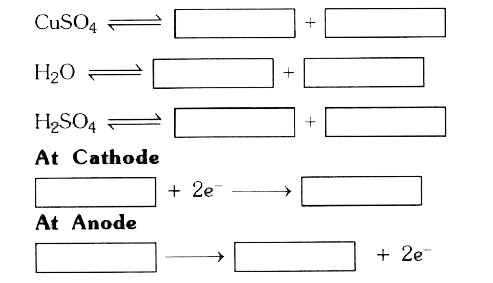Write the equations for the reactions taking place at the two electrodes (mentioning clearly the name of the electrode ) during the electrolysis of
Acidified copper sulphate solution with copper electrodes .
(ii) Molten lead bromide with (graphite ) electrodes .
Step-by-Step Solution:
1. Identify the Electrodes:
- Anode: Positive electrode (where oxidation occurs)
- Cathode: Negative electrode (where reduction occurs)
2. Reactions at the Anode:
- At the anode, copper (Cu) is oxidized to copper ions (Cu²⁺) and releases electrons.
- Reaction:
Cu (s)→Cu2+(aq)+2e−
3. Reactions at the Cathode:
- At the cathode, copper ions (Cu²⁺) are reduced to solid copper (Cu) by gaining electrons.
- Reaction:
Cu2+(aq)+2e−→Cu (s)
(ii) Electrolysis of Molten Lead Bromide with Graphite Electrodes
1. Identify the Electrodes:
- Anode: Positive electrode (where oxidation occurs)
- Cathode: Negative electrode (where reduction occurs)
2. Reactions at the Anode:
- At the anode, bromide ions (Br⁻) are oxidized to bromine (Br₂) and release electrons.
- Reaction:
2Br−(l)→Br2(g)+2e−
3. Reactions at the Cathode:
- At the cathode, lead ions (Pb²⁺) are reduced to solid lead (Pb) by gaining electrons.
- Reaction:
Pb2+(l)+2e−→Pb (s)
Summary of Reactions:
- Acidified Copper Sulphate Solution with Copper Electrodes:
- Anode: Cu (s)→Cu2+(aq)+2e−
- Cathode: Cu2+(aq)+2e−→Cu (s)
- Molten Lead Bromide with Graphite Electrodes:
- Anode: 2Br−(l)→Br2(g)+2e−
- Cathode: Pb2+(l)+2e−→Pb (s)
- Anode: Positive electrode (where oxidation occurs)
- Cathode: Negative electrode (where reduction occurs)
- At the anode, copper (Cu) is oxidized to copper ions (Cu²⁺) and releases electrons.
- Reaction:
Cu (s)→Cu2+(aq)+2e−
- At the cathode, copper ions (Cu²⁺) are reduced to solid copper (Cu) by gaining electrons.
- Reaction:
Cu2+(aq)+2e−→Cu (s)
- Anode: Positive electrode (where oxidation occurs)
- Cathode: Negative electrode (where reduction occurs)
- At the anode, bromide ions (Br⁻) are oxidized to bromine (Br₂) and release electrons.
- Reaction:
2Br−(l)→Br2(g)+2e−
- At the cathode, lead ions (Pb²⁺) are reduced to solid lead (Pb) by gaining electrons.
- Reaction:
Pb2+(l)+2e−→Pb (s)
- Acidified Copper Sulphate Solution with Copper Electrodes:
- Anode: Cu (s)→Cu2+(aq)+2e−
- Cathode: Cu2+(aq)+2e−→Cu (s)
- Anode: 2Br−(l)→Br2(g)+2e−
- Cathode: Pb2+(l)+2e−→Pb (s)
Similar Questions
Write equations for the reactions taking place at the two electrodes (mentioning clearly the name of the electrode) during the electrolysis of:
Acidified copper sulphate solution with copper electrodes.
View SolutionWrite equations for the reactions taking place at the two electrodes (mentioning clearly the name of the electrode) during the electrolysis of:
Molten lead bromide with inert electrodes.
View Solution
Knowledge Check
The ion which is discharged at the cathode during the electrolysis of copper sulphate solutions using copper electrodes an anode and cathode ?
ACu2+BOH−CSO2−4DH+
State the observations at the anode and at the cathode during the electrolysis of :
copper sulphate solution using copper electrodes.
View SolutionComplete the following table with respect to electrolysis of acidulated copper sulphate solution using copper electrode :

View SolutionWrite the reactions at the cathode and at the anode during electrolysis of copper sulphate using copper electrode.
View SolutionState the electrode reaction at the anode during electrolysis of:
aqueous copper sulphate using platinum electrodes
View SolutionState the electrode reaction at the anode during electrolysis of:
acidified water.
View SolutionWrite separate equations for the reactions which take place at the two electrodes when dilute sulphuric acid is electrolysed between two platinum electrodes .
View SolutionName the product formed at the anode during the electrolysis of acidified water using platinum electrodes.
View Solution
